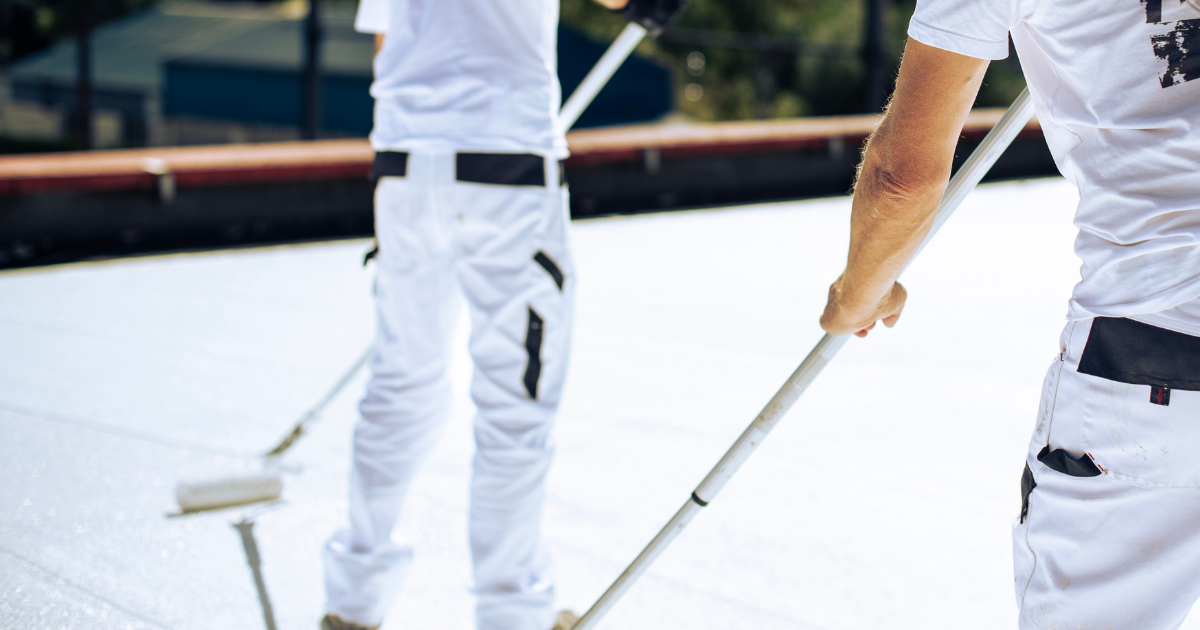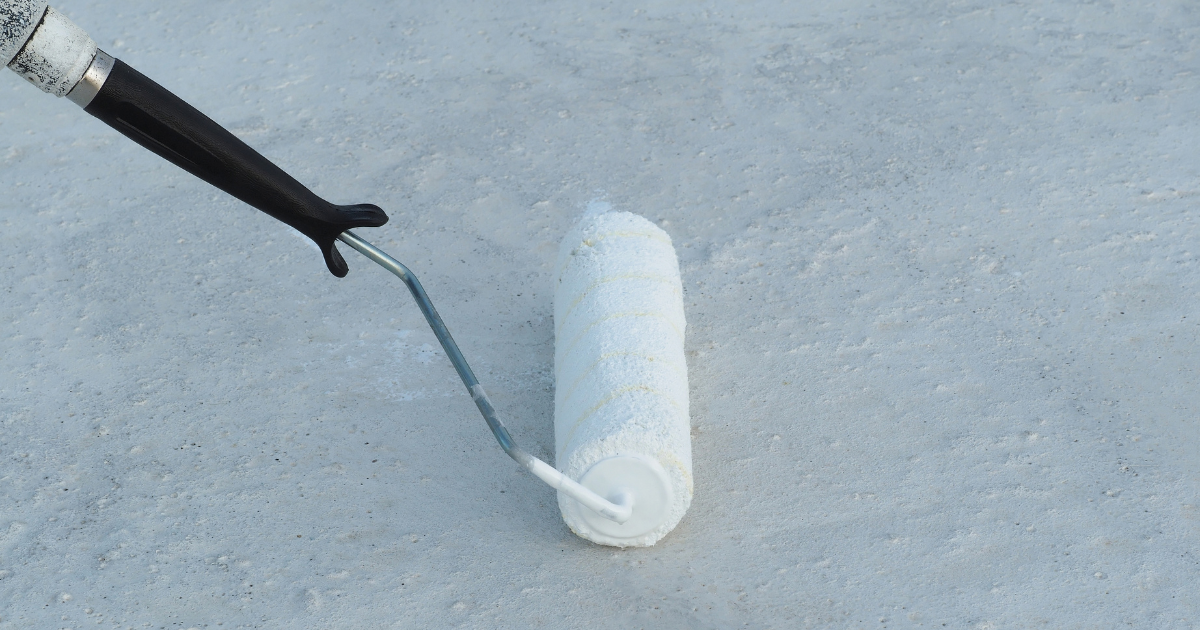
Flat roofs in commercial buildings are often working surfaces – they can be platforms for HVAC systems, ventilation units, solar panels, and even access points for maintenance teams. Unlike sloped ones, these rooftops are designed to be used. But with that functionality comes exposure to constant wear and tear, much of which goes unnoticed until damage is already underway.
If you own or manage a facility with a flat roof, you may have seen puddles linger after storms, noticed dark patches where coatings are worn down, or received complaints about temperature inconsistencies from the floors below. These are all red flags that your roof is not being maintained to meet the demands placed on it.
“Your roof is not a passive feature – it’s a working surface. And every day of foot traffic adds risk unless you actively protect it.” – Rick Dodaj, Founder of Silicoat Roofing.
We understand the pressure high-use roofs endure, and design our systems specifically to address them. This article will walk you through everything you need to know about flat roof maintenance in high-traffic commercial environments – what to watch out for, how to prevent damage, and how Silicoat Roofing can protect your investment long-term.
Why High-Traffic Roofs Need Special Attention
Most flat roofs are designed with general weather resistance in mind, but high-traffic ones deal with much more. Whether you’re running a healthcare facility with constant rooftop unit servicing or a distribution center with heavy HVAC cycling, the daily demands on your roof can escalate fast.
Frequent Foot Traffic Means Compounded Damage
Even the best commercial membranes can break down under the pressure of routine use. Foot traffic from contractors, maintenance teams, or utility providers introduces pressure points that weaken the roof’s surface over time. Plus, footwear, toolkits, rolling carts, and ladders create friction, which can gradually erode the protective top layer of your roofing system.
And it’s not just people – equipment installations, solar panel servicing, and even wildlife can contribute to punctures, blisters, or membrane separation if unchecked.
The Role of Equipment Load and Access Pathways
Rooftop units like chillers, exhaust fans, and telecom towers contribute significant static weight and require regular access for servicing. Without defined walkways or reinforced zones, the paths technicians take wear down faster, creating uneven surface pressure that leads to accelerated breakdown.
Establishing designated walk pads, outlined traffic lanes, and limiting random access helps mitigate this, but only if it’s part of a broader roof protection plan.
Weather, UV, and Environmental Stressors
The weather impact on roofs and commercial building performance cannot be overstated. All commercial roofs face exposure to heat, cold, rain, and UV rays. But high-traffic roofs face this while already weakened from human activity. Sunlight causes thermal cycling (expansion and contraction), which fatigues materials. UV rays break down coatings. And moisture intrusion, when left to pool or freeze, compromises the insulation and underlying structure.
High-traffic makes all of this worse, and much faster.
Building a Smart Flat Roof Maintenance Plan
So how do you stay ahead of these threats? The answer is a comprehensive, custom maintenance plan. Not a one-size-fits-all checklist, but a roadmap tailored to your building’s specific needs, usage patterns, and budget.
Quarterly Inspections: Your First Line of Defense
Most commercial building codes only require annual roof inspections, but that’s not enough for high-traffic roofs. We recommend quarterly inspections at a minimum. Each review should look for membrane degradation, loose flashing, pooling water, seam separations, and any signs of puncture.
These inspections are especially important after:
- Storm events
- New mechanical installations
- Heavy maintenance cycles
Document each visit and use photos to track changes over time. This helps justify repairs or insurance claims and allows early detection of wear trends. Remember – don’t underestimate the power of regular commercial roof inspections.
Drainage and Debris Management
Flat roofs are notorious for water retention issues. Leaves, tools, and debris from maintenance crews can block internal drains and scuppers, allowing standing water to collect. Over time, this water seeps into any existing cracks, accelerating degradation and encouraging mold or moss growth. That’s why preventing water damage in commercial roofs requires more than just surface repairs, it demands a proactive drainage strategy.
Regular drain checks, especially after windy or stormy days, should be a key part of your routine. Many facility managers choose to add leaf guards or internal alarms for backed-up drainage.
Flashing, Sealants, and Penetration Points
Every pipe boot, vent stack, and structural penetration is a potential leak point. These elements shift slightly over time due to thermal movement and building settling. Flashing and sealants around these areas tend to degrade faster than field membrane and need consistent resealing to maintain their integrity.
Silicoat-trained teams pay special attention to these zones during routine visits and recommend reinforcing high-risk areas with compatible patch materials or coatings.
Mapping Roof Access and Limiting Exposure
One of the simplest, most cost-effective strategies is limiting access to your roof. Install clearly marked walk paths with anti-slip pads, restrict entry to trained personnel, and require tracking for all rooftop visits.
Some buildings implement access logs, security cams, or even QR-coded roof zones to monitor usage. The goal is to ensure that only authorized traffic enters the most sensitive zones.

Surface Protection
Routine checks and strong policies are vital, but they only work if the surface material is built to withstand high usage. Silicoat Roofing uses high-performance systems designed specifically for these demanding environments.
Why Silicone Works
Silicone coatings differ from traditional roofing products in three key ways:
- They stay flexible in all temperatures – from blistering heat to sub-zero cold.
- They resist standing water better than acrylic or asphalt.
- They bond to a wide variety of substrates, which makes them ideal for roof restorations.
In high-traffic zones, flexibility matters. While traditional membranes may crack or delaminate under pressure, silicone systems absorb impact and retain their seal. And because they reflect sunlight, they lower surface temperatures, extending both roof life and HVAC efficiency.
Strengthening High-Traffic Zones
Our team reinforces service walkways and heavy-use zones with textured silicone topcoats or additional membrane layers. These coatings include grit additives for slip resistance and are designed to handle rolling carts and foot traffic without scuffing or cracking.
Facilities with rooftop access ladders, staging areas, or tenant mechanical zones should always reinforce those sections during re-coating.
Seamless Application and Fast Curing
Unlike traditional roof replacement, which may shut down sections of your building or require weeks of labor, silicone coatings can be applied quickly and cure rapidly, typically within 24 hours. That means minimal disruption to operations and faster turnaround times.
This makes our system ideal for busy facilities where downtime isn’t an option.
Planning for Long-Term Durability and ROI
Flat roof maintenance isn’t just about extending the roof’s life, it’s ultimately about optimizing every dollar you spend. Planned maintenance and smart material choices help you avoid emergency repairs, meet sustainability goals, and protect your tenants or staff.
Lifecycle Forecasting
Your roof’s life isn’t static, it’s a curve. Early on, performance is high, but once wear accumulates, degradation accelerates. A smart plan recognizes these curves and schedules:
- Minor recoats every 10–15 years
- Reinforcement in high-traffic spots after 5–7 years
- Full coating re-application based on annual performance testing
This keeps your system working at peak performance and avoids the steep costs of emergency fixes or full replacement.
Data-Driven Decision Making
Today’s smart facility management software allows you to track roof performance over time. With drones, infrared imaging, and moisture scanners, you can detect problems before they reach the interior. These tools support your maintenance team in making proactive, cost-saving decisions.
Energy Savings and Environmental Impact
Reflective silicone roofs don’t just protect the surface, they also help reduce your building’s overall energy consumption. According to the U.S. Department of Energy, cool roofs can reduce rooftop temperatures by more than 50°F, significantly easing the strain on HVAC systems during hot weather. This enhanced reflectivity can lower cooling energy use by up to 10-15%, depending on climate and building type. In fact, many states and local governments also offer rebates or tax incentives to encourage the use of reflective roofing systems, helping to offset installation costs and accelerate return on investment.
Why Silicoat Roofing is the Go-To Partner
We know that as a facility manager or commercial property owner, you’re juggling a dozen systems at once – HVAC, electrical, compliance, tenant coordination. You need roofing partners who make your life easier, not harder.
Specialized Experience
Silicoat has worked with office parks, logistics warehouses, schools, hospitals, and retail plazas all across Detroit. We understand the site limitations, schedule demands, and long-term goals of each project type. Whether you’re prepping for a code inspection or upgrading for LEED compliance, we’ve got the expertise to guide you.
Turnkey Process, Transparent Communication
From the initial inspection through final application and documentation, we handle everything. Our team works around your schedule, prioritizes safety, and gives you clear reporting so there are no surprises.
Warranty-Backed Peace of Mind
Our silicone systems come with manufacturer warranties up to 20 years. We stand by our work with integrity, and we remain available for follow-ups, evaluations, and post-installation support.

Common Questions About Flat Roof Maintenance for High-Traffic Zones
Is silicone coating slippery when wet?
Not with grit additives or walk pad overlays. Silicoat uses textured finishes in service areas to ensure technician safety.
How much downtime should I expect?
Most silicone coating applications are completed within 1–3 days, depending on weather and building size—with minimal operational interruption.
Do I need to remove my old roof first?
In many cases, no. Silicoat’s systems are compatible with most commercial roofing substrates and can be installed over existing surfaces after proper prep.
Will my warranty be voided if other contractors go on the roof?
Not if you follow access control and maintenance documentation. We help you implement roof protection best practices to keep your coverage intact.
Don’t Wait Until the Leaks Start
Your commercial flat roof is more than a cover, it’s part of your building’s infrastructure. Every day it faces stress from equipment, weather, and people. Without protection, it’s just a matter of time before problems surface.
With Silicoat Roofing, you gain a trusted partner who knows how to reinforce high-traffic rooftops for durability, energy efficiency, and long-term ROI.
Protect your investment today! Contact us for your free consultation and get peace of mind built into every square foot.
About the Author
Rick Dodaj is the founder and CEO of Silicoat Roofing, specializing in commercial roofing solutions that protect businesses and their investments. With extensive experience in commercial roofing, Rick leads a team dedicated to providing cost-effective, long-lasting roofing solutions. Connect with him on LinkedIn to learn more about commercial roof maintenance and protection strategies.


 Previous Post
Previous Post Next Post
Next Post